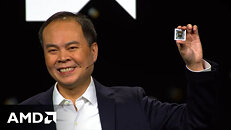
AMD Teases "Not Available For Purchase" Radeon RX 9060 XT Reference Card Design
In an almost uncanny case of recent history repeating itself, AMD has kicked off another RDNA 4 new product teaser campaign. Today's reminder—regarding Jack Huynh's upcoming Computex presentation—included a promotional render of a stubbier dual-fan Radeon RX 9000 Series card design. Casting our memories back to late January (2025), Team Red rolled out an ill-timed advertisement—not long after the official delay of Radeon RX 9070 XT and non-XT cards. Despite denying the existence of "Made-By-AMD" (MBA) reference designs, AMD staffers were likely enraged by Chinese black market channel offerings of alleged "real deal examples." Days after first wave RDNA 4's March 6 global launch, a triple-fan specimen was outed.
Throughout early Q2, insiders and members of the Chiphell forum have played around with Radeon RX 9070 XT and RX 9070 MBA cards. The latter unit (see photo below) seems to utilize a dual-fan configuration in a fairly long enclosure format. Team Red's latest promo post likely points to a forthcoming unveiling of Radeon RX 9060 XT partner models, but curious industry observers will be wondering whether the shorter reference design actually exists in real life. As per usual, a tiny disclaimer claims otherwise: "Artistic Render. Not Available For Purchase." So far, leaks have suggested the presence of Acer, ASUS, GIGABYTE, and XFX custom options during introductory proceedings. Today's refresher outlined upcoming new product categories and partner contributions: "join AMD on May 21 as we reveal what's next in gaming, AI PCs, and more. (Our) SVP and GM of Computing and Graphics Group, along with industry leaders and partners showcase what is built to power the next level."
Throughout early Q2, insiders and members of the Chiphell forum have played around with Radeon RX 9070 XT and RX 9070 MBA cards. The latter unit (see photo below) seems to utilize a dual-fan configuration in a fairly long enclosure format. Team Red's latest promo post likely points to a forthcoming unveiling of Radeon RX 9060 XT partner models, but curious industry observers will be wondering whether the shorter reference design actually exists in real life. As per usual, a tiny disclaimer claims otherwise: "Artistic Render. Not Available For Purchase." So far, leaks have suggested the presence of Acer, ASUS, GIGABYTE, and XFX custom options during introductory proceedings. Today's refresher outlined upcoming new product categories and partner contributions: "join AMD on May 21 as we reveal what's next in gaming, AI PCs, and more. (Our) SVP and GM of Computing and Graphics Group, along with industry leaders and partners showcase what is built to power the next level."












































































